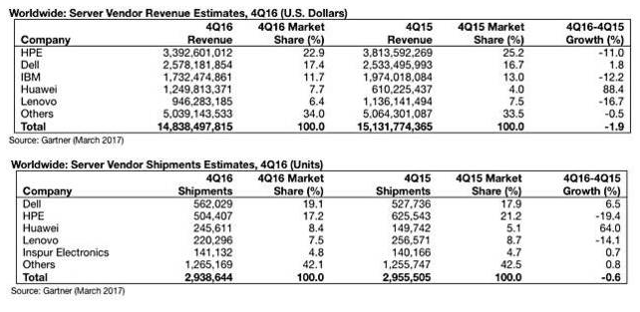
Amazon Web Services had a bad day this week, and when AWS has a bad day, so does the rest of the internet. AWS had a 4-hour outage on Monday caused by human error. Later in the week, the company reported that they have put processes in place to prevent this type of issue from occurring again.
IBM is making news for gaining a patent for out-of-office email responses. IBM then made news for being ridiculed for attempting to patent basic technology that has been around for over a decade. Big blue made news a third time for offering the patent up for public use.
Acquisitions

No acquisitions for two weeks in a row…
Artificial Intelligence
- Afraid of A.I. taking your job? Yep, you likely are
Only 4% of 2,000 people surveyed said they thought emerging technologies would make their jobs easier, while 48% of those familiar with the idea of disruptive technologies fear it will cause layoffs in their industry and more than 38% said it might cost them their jobs personally. This is according to a new study from SelectHub, a company focused on helping enterprises make technology decisions.
Cloud
- The day Amazon S3 storage stood still
By now you’ve probably heard that Amazon’s S3 storage service went down in its Northern Virginia datacenter for the better part of 4 hours yesterday, and took parts of a bunch of prominent websites and services with it.
It’s worth noting that as of this morning, the Amazon dashboard was showing everything was operating normally.
Additional Background:
Amazon S3 is used by around 148,213 websites, and 121,761 unique domains, according to data tracked by SimilarTech, and its popularity as a content host concentrates specifically in the U.S. It’s used by 0.8 percent of the top 1 million websites, which is actually quite a bit smaller than CloudFlare, which is used by 6.2 percent of the top 1 million websites globally – and yet it’s still having this much of an effect.
Information on S3’s historical uptime:
To provide some additional perspective, CloudHarmony, a service that tracks cloud outages reports that S3 has typically exceeded its Service Level Agreement (SLA), which promises that the service will be up 99.9 percent of the time and offers refunds for those times when it’s not. CloudHarmony found that in most cases S3 has achieved 100 percent annual availability since the company began monitoring cloud services in 2014. The notable exception was an S3 outage in August, 2015.
https://techcrunch.com/2017/03/01/the-day-amazon-s3-storage-stood-still/?ncid=rss
The root cause was human errorAmazon apologized for the disruption on the AWS services page. It writes that a Simple Storage Service (S3) engineer was debugging an issue causing the S3 billing service to run slowly. They “executed a command which was intended to remove a small number of servers for one of the S3 subsystems that is used by the S3 billing process.”
“Unfortunately, one of the inputs to the command was entered incorrectly and a larger set of servers was removed than intended. The servers that were inadvertently removed supported two other S3 subsystems. One of these subsystems, the index subsystem, manages the metadata and location information of all S3 objects in the region.”
http://www.techspot.com/news/68381-cause-amazon-web-service-failure-resulted-parts-internet.html
- AWS Taking On Microsoft, Google with Productivity Suite
Sources told The Information that AWS is still in the early development stages with its productivity suite and hasn’t ironed out exactly what apps it would include. The company is reportedly working to upgrade its existing WorkMail and WorkDocs to appeal to more corporate customers.
http://www.geekwire.com/2017/amazon-may-take-microsoft-google-new-aws-productivity-suite/
- Box’s Levie touts positive cash flow
The company celebrated its first quarter as a free cash flow (FCF) positive business, with CEO Aaron Levie characterizing this as an “inflection point” in a call with TechCrunch. FCF was $10.2 million for the quarter, which they say is a $30 million gain year-over-year.
But Wall Street was disappointed that Box cautioned its first-quarter earnings would likely lose 14 to 15 cents per share, worse than the negative 12 cents investors are watching for.
https://techcrunch.com/2017/03/01/boxs-levie-touts-positive-cash-flow/?ncid=rss
Datacenter
- Why so sad HPE, IBM, Lenovo? Server sales? Let’s see… ah. Oh dear
Overall, according to Gartner research VP Jeffrey Hewitt: “x86 servers continue to be the predominant platform used for large-scale data center build-outs across the globe, and the growth of integrated systems (including hyperconverged integrated systems), while still relatively small as an overall percentage of the hardware infrastructure market, also provided a boost to the x86 server space for the year.”
https://www.theregister.co.uk/2017/03/02/server_market_shrinks/

- IBM flash storage key to turnaround, says GM Walsh
Look at how you use data to drive your business through better insights. Say you’re doing a poll to get some analytics. How do you run the poll? How do you tell the system, ‘Tell me … this answer,’ and then put some understanding around the answer. Cognitive is placing reason around the data so you understand it and get help with decision-making. Those applications takes a lot of CPU and memory, so flash media allows you to do those things better.
- HPE’s struggles might have something to do with Microsoft
While Microsoft has been deploying some white-box servers for years, the company seems to have stepped up its efforts lately. In October, the company unveiled Project Olympus, a design for modular servers featuring internally-designed motherboards and power supplies. Olympus is being contributed to the Open Compute Project (OCP), a Facebook-led initiative to create open-source designs for low-power data center hardware.
Software/SaaS
- Zipnosis, PokitDok intertwine claims processing and telemedicine
“PokitDok designed claims administration tools to support emerging digital health companies like Zipnosis,” said Lisa Maki, co-founder and CEO of PokitDok. “This engagement really hit our sweet spot: working to strip costs and unproductive time out of clinical visits. We leveraged our HIPAA-compliant data connections to health insurers and payers to facilitate this new workflow. The result is quality care delivery with improved efficiency.”
Other
- IBM Shamed Into Giving Away Awful Patent On Email Out-Of-Office Messages
So IBM spent tons of money not just applying for this patent, but arguing back and forth with the PTO for years over why it truly deserved this silly patent… and then it got it at the beginning of this year. And less than two months after receiving the patent, when the EFF publicly shames IBM over the patent, the company then says “oh, hey, we dedicate it to the public.” That makes sense.
Photo: AJ Montpetit

